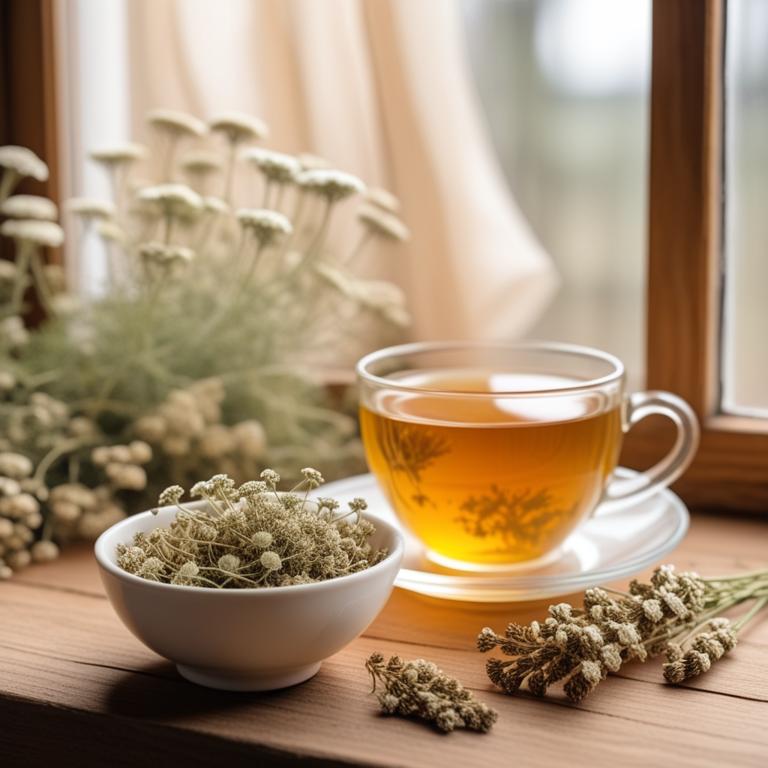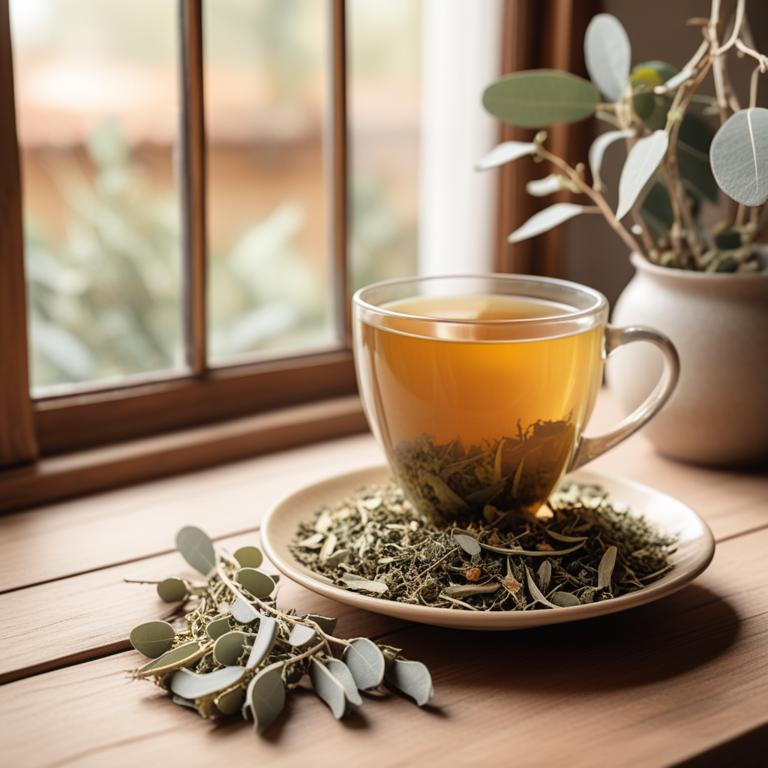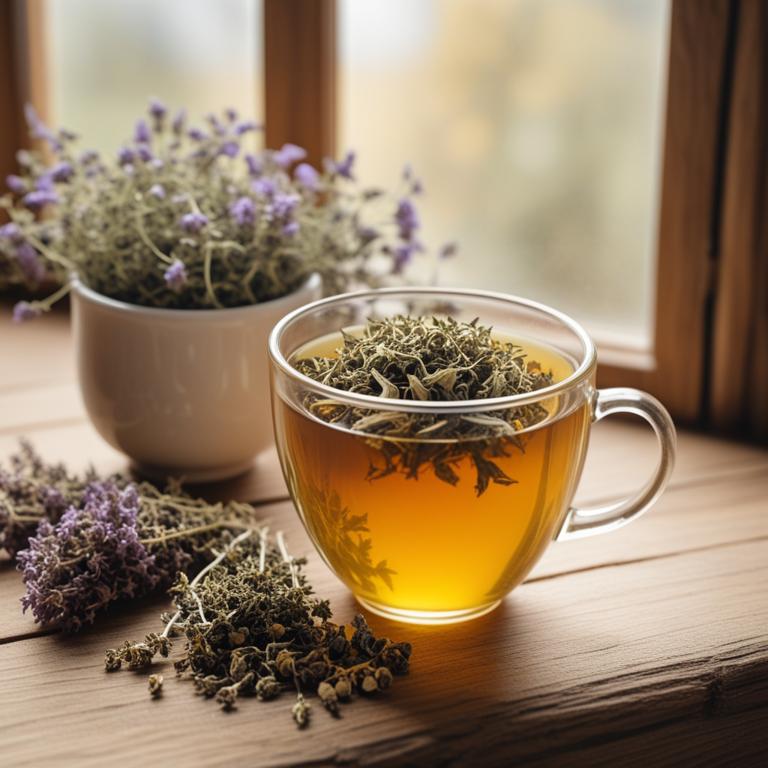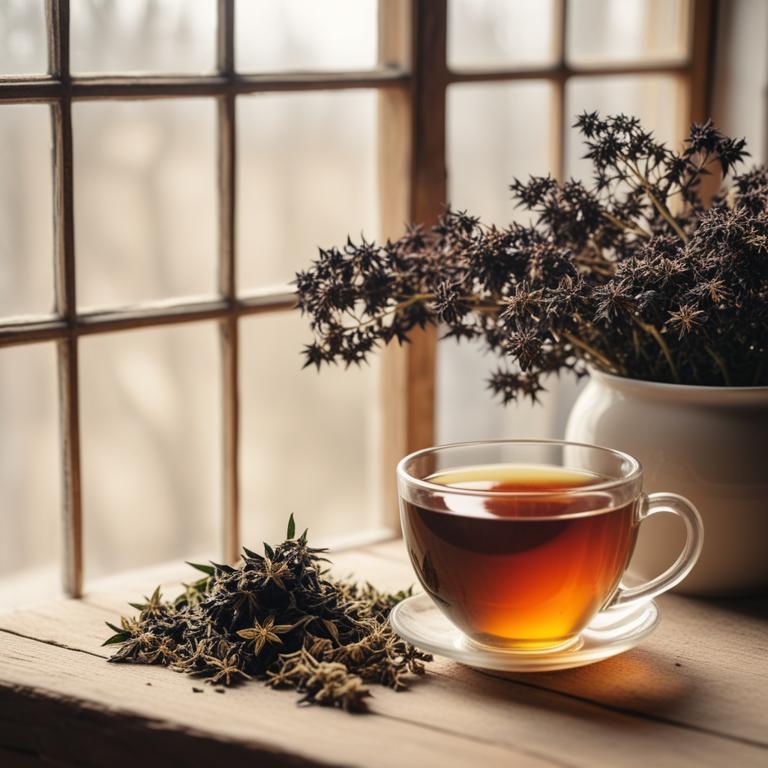9 Herbal Teas For Tickling Throat

Herbal teas can be a soothing remedy for a tickling throat.
This happens because these teas often contain anti-inflammatory compounds that calm down the throat and reduce swelling. For example, Glycyrrhiza glabra, also known as licorice root, has a natural anti-inflammatory property that helps to reduce throat irritation. Eucalyptus globulus, commonly used in cough drops and inhalers, contains eucalyptol, an oil that breaks down mucus and eases congestion.
Echinacea purpurea is another herb that has been shown to boost the immune system, helping to fight off infections that can cause a tickling throat. Drinking these herbal teas can provide quick relief from a tickling throat, allowing you to speak, eat and breathe more comfortably. This can be especially helpful during cold and flu season, or when you're experiencing allergies.
By incorporating herbal teas into your daily routine, you can reduce your reliance on over-the-counter medications and enjoy a more natural approach to managing a tickling throat.
- 1. Glycyrrhiza glabra
- 2. Eucalyptus globulus
- 3. Echinacea purpurea
- 4. Zingiber officinale
- 5. Rosmarinus officinalis
- 6. Thymus vulgaris
- 7. Lavandula angustifolia
- 8. Sambucus nigra
- 9. Achillea millefolium
1. Glycyrrhiza glabra

Glycyrrhiza glabra teas contains compounds like glycyrrhizin and flavonoids, which have anti-inflammatory properties that help soothe a tickling throat.
Glycyrrhizin reduces inflammation in the mucous membranes, making it less likely for them to become irritated and swollen. Flavonoids, on the other hand, have antioxidant properties that help protect the throat from damage caused by free radicals. The licorice root in Glycyrrhiza glabra teas also has a coating effect that can help calm an irritated throat.
By reducing inflammation and protecting the mucous membranes, Glycyrrhiza glabra teas can help alleviate a tickling throat.
- Gather 1 cup of water and 1 tablespoon of dried Glycyrrhiza glabra root.
- Heat the water in a pot until it boils.
- Add the dried Glycyrrhiza glabra root to the boiling water and let it steep for 5-7 minutes.
- Strain the mixture into a cup and discard the root.
- Drink the tea hot or warm, 2-3 times a day to soothe a tickling throat.
2. Eucalyptus globulus

Eucalyptus globulus teas contains compounds like eucalyptol, borneol, and alpha-pinene.
These bioactive constituents have anti-inflammatory properties that help reduce swelling in the throat, making it easier to swallow and breathe. Eucalyptol, in particular, has natural decongestant properties that break down mucus and ease congestion, allowing for clearer airways. The expectorant properties of alpha-pinene help loosen and clear out mucus, further relieving congestion and coughs.
By reducing inflammation and loosening mucus, Eucalyptus globulus teas helps provide relief for a tickling throat.
- Gather 1 cup of fresh eucalyptus leaves (Eucalyptus globulus) or 1 teaspoon of dried eucalyptus leaves.
- Boil 1 cup of water and let it cool for 1 minute.
- Add the eucalyptus leaves to the cooled water and let it steep for 5-7 minutes.
- Strain the mixture using a tea strainer or cheesecloth into a cup.
- Drink the eucalyptus tea while it's warm to help soothe a tickling throat.
3. Echinacea purpurea

Echinacea purpurea teas contains several bioactive constituents that help soothe a tickling throat.
These include alkylamides, which have anti-inflammatory properties that reduce swelling and pain in the throat. Flavonoids, such as kaempferol and quercetin, also present in the tea, have antioxidant properties that help fight off infections that can cause a tickling sensation. The tea's content of caffeic acid, a phenolic acid, has been shown to inhibit the production of pro-inflammatory compounds that can exacerbate a tickling throat.
By reducing inflammation and fighting off infections, Echinacea purpurea teas can help alleviate a tickling throat and provide relief from associated discomfort.
- Gather 1 teaspoon of dried Echinacea purpurea root and flowers.
- Measure 1 cup of boiling water in a teapot.
- Add the Echinacea mixture to the boiling water and let it steep for 5-7 minutes.
- Strain the tea into a cup and add honey to taste, if desired.
- Drink the tea warm, 2-3 times a day, to help soothe a tickling throat.
4. Zingiber officinale

Zingiber officinale teas contains active constituents like gingerols and shogaols.
These compounds have anti-inflammatory properties that help reduce swelling in the throat. The antioxidants present in ginger, such as gingerols and shogaols, also have a soothing effect on the throat, reducing irritation and discomfort. Additionally, the warming properties of ginger help increase blood flow to the throat area, which can help ease congestion and coughs.
By reducing inflammation and promoting blood flow, Zingiber officinale teas can help provide relief for a tickling throat.
- Get 1 tablespoon of dried Zingiber officinale root.
- Boil 1 cup of water in a pot.
- Add the dried root to the boiling water and let it steep for 5-7 minutes.
- Strain the mixture into a cup and discard the root.
- Drink the tea while it's warm to soothe your tickling throat.
Zingiber Officinale Tea on Amazon
FGO Organic Ginger Tea, 100 Count, Eco-Conscious Tea Bags, Caffeine Free, Packaging May Vary (Pack of 1)
Disclaimer: We earn a commission if you click this link and make a purchase at no additional cost to you.
5. Rosmarinus officinalis

Rosmarinus officinalis teas contains rosmarinic acid and carnosic acid as its bioactive constituents.
These compounds have anti-inflammatory and antioxidant properties, which can help soothe an itchy throat. Rosmarinic acid, in particular, has been shown to reduce inflammation and relieve respiratory issues, making it an effective ingredient for alleviating throat irritation. The antioxidant properties of carnosic acid help protect the throat from damage caused by free radicals, further reducing discomfort.
By consuming Rosmarinus officinalis teas, you may experience relief from throat irritation due to its anti-inflammatory and antioxidant effects.
- Gather 1 cup of fresh or dried Rosmarinus officinalis leaves.
- Measure 1 cup of boiling water and pour it over the leaves in a teapot.
- Let it steep for 5-7 minutes, then strain the liquid into a cup.
- Add 1 tablespoon of honey to the tea for taste, if desired.
- Drink the tea warm or at room temperature to soothe a tickling throat.
6. Thymus vulgaris

Thymus vulgaris teas contains thymol and carvacrol, which are antibacterial and anti-inflammatory compounds.
These properties help reduce inflammation in the throat, making it an effective remedy for soothing a tickling throat. Thymol, in particular, has natural decongestant properties that can help clear out mucus and reduce congestion. Carvacrol has antioxidant properties that can help protect the throat from damage caused by free radicals.
By drinking Thymus vulgaris teas, you can take advantage of these compounds to help calm a tickling throat.
- Gather 1 cup of fresh Thymus vulgaris leaves or 2 teaspoons of dried leaves.
- Heat 1 cup of boiling water in a kettle or pot.
- Add the Thymus vulgaris leaves to the boiling water and let it steep for 5-7 minutes.
- Strain the tea into a cup using a tea strainer or cheesecloth.
- Drink the tea warm or at room temperature to soothe a tickling throat.
7. Lavandula angustifolia

Lavandula angustifolia teas contains compounds like linalool and linalyl acetate, which have anti-inflammatory and soothing properties.
These properties can help calm an itchy or irritated throat, reducing inflammation and discomfort. The antispasmodic effect of linalool helps relax the muscles in the throat, relieving spasms and making it easier to swallow. The antimicrobial properties of linalyl acetate also help fight off infections that can cause a sore throat.
The combination of these properties in Lavandula angustifolia teas makes it a natural remedy for soothing a tickling throat.
- Gather 1 cup of fresh Lavandula angustifolia flowers or 1 tablespoon of dried flowers.
- Heat 1 cup of water in a pot until it reaches a boil.
- Add the Lavandula angustifolia flowers to the boiling water and let it steep for 5-7 minutes.
- Strain the tea into a cup using a sieve or cheesecloth to remove the flowers.
- Drink the tea slowly while it's still warm to soothe your tickling throat.
8. Sambucus nigra

Sambucus nigra teas contains flavonoids, particularly quercetin, and phenolic acids like ferulic acid and sinapic acid.
These compounds have anti-inflammatory properties, which help to soothe a tickling throat by reducing swelling and irritation. Sambucus nigra also contains essential oils like borneol and borneol acetate, which have expectorant properties, helping to loosen and clear mucus from the airways. The flavonoids in Sambucus nigra also have antioxidant properties, which can help to protect the throat from damage caused by free radicals.
By reducing inflammation and loosening mucus, Sambucus nigra teas can help to relieve a tickling throat and promote a more comfortable respiratory system.
- Gather 2 tablespoons of dried Sambucus nigra flowers.
- Boil 1 cup of water in a pot.
- Add the dried flowers to the boiling water and remove from heat.
- Let it steep for 5-7 minutes, then strain the mixture.
- Drink the tea while warm, 2-3 times a day as needed.
9. Achillea millefolium

Achillea millefolium teas contains several bioactive constituents that help soothe a tickling throat.
One of the main compounds is sesquiterpene lactone, which has anti-inflammatory properties that reduce swelling and ease pain in the throat. The tea also contains apigenin, a flavonoid that has natural antiseptic and antibacterial properties, helping to combat infections and reduce irritation in the throat. Additionally, the tea contains flavonoids like luteolin and kaempferol, which have antioxidant properties that help reduce inflammation and promote healing in the throat.
By consuming Achillea millefolium tea, you may find relief from the discomfort and irritation associated with a tickling throat.
- Gather 1 cup of dried Achillea millefolium flowers and 1 cup of boiling water in a teapot.
- Steep the flowers in boiling water for 5-7 minutes, then strain the mixture into a cup.
- Add 1-2 tablespoons of honey to the tea, if desired, to sweeten the flavor.
- Drink the tea hot, ideally 2-3 times a day, to help soothe a tickling throat.
- Store any leftover tea in the refrigerator for up to 24 hours, and reheat it when needed.